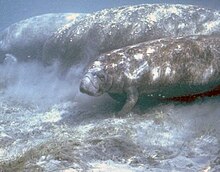|
List of mammals of the U.S. Virgin IslandsThis is a list of the mammal species recorded in the U.S. Virgin Islands. Of the native mammal species in the U.S. Virgin Islands, two are vulnerable and one species has been classified as extinct.[1] The following tags are used to highlight each species' conservation status as assessed by the International Union for Conservation of Nature:
Some species were assessed using an earlier set of criteria. Species assessed using this system have the following instead of near threatened and least concern categories:
Subclass: TheriaInfraclass: EutheriaOrder: Sirenia (manatees and dugongs) Sirenia is an order of fully aquatic, herbivorous mammals that inhabit rivers, estuaries, coastal marine waters, swamps, and marine wetlands. All four species are endangered.
Order: Rodentia (rodents)Rodentia is an order of mammals characterised by two continuously growing incisors in the upper and lower jaws which must be kept short by gnawing.
Order: Chiroptera (bats)The bats' most distinguishing feature is that their forelimbs are developed as wings, making them the only mammals capable of flight. Bat species account for about 20% of all mammals.
Order: Cetacea (whales)The order Cetacea includes whales, dolphins and porpoises. They are the mammals most fully adapted to aquatic life with a spindle-shaped nearly hairless body, protected by a thick layer of blubber, and forelimbs and tail modified to provide propulsion underwater.     The order Cetacea includes whales, dolphins and porpoises. They are the mammals most fully adapted to aquatic life with a spindle-shaped nearly hairless body, protected by a thick layer of blubber, and forelimbs and tail modified to provide propulsion underwater.
Order: Carnivora (carnivorans)There are over 260 species of carnivorans, the majority of which feed primarily on meat. They have a characteristic skull shape and dentition. The order Carnivora is represented in the U.S. Virgin Islands by an introduced species, the small Indian mongoose (Herpestes auropunctatus), which is a species of mongoose found in the wild in South and Southeast Asia. It has been introduced to various parts of the world, including the Caribbean. In addition, the Caribbean monk seal frequently visited many of the islands, but is now classified as extinct.
See also
Notes
References
|